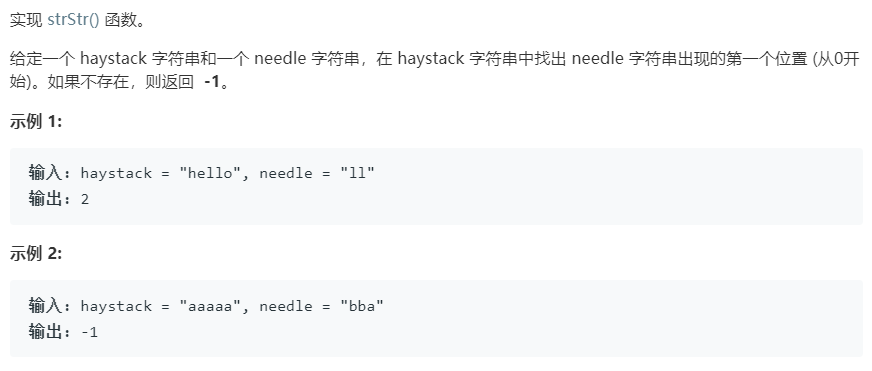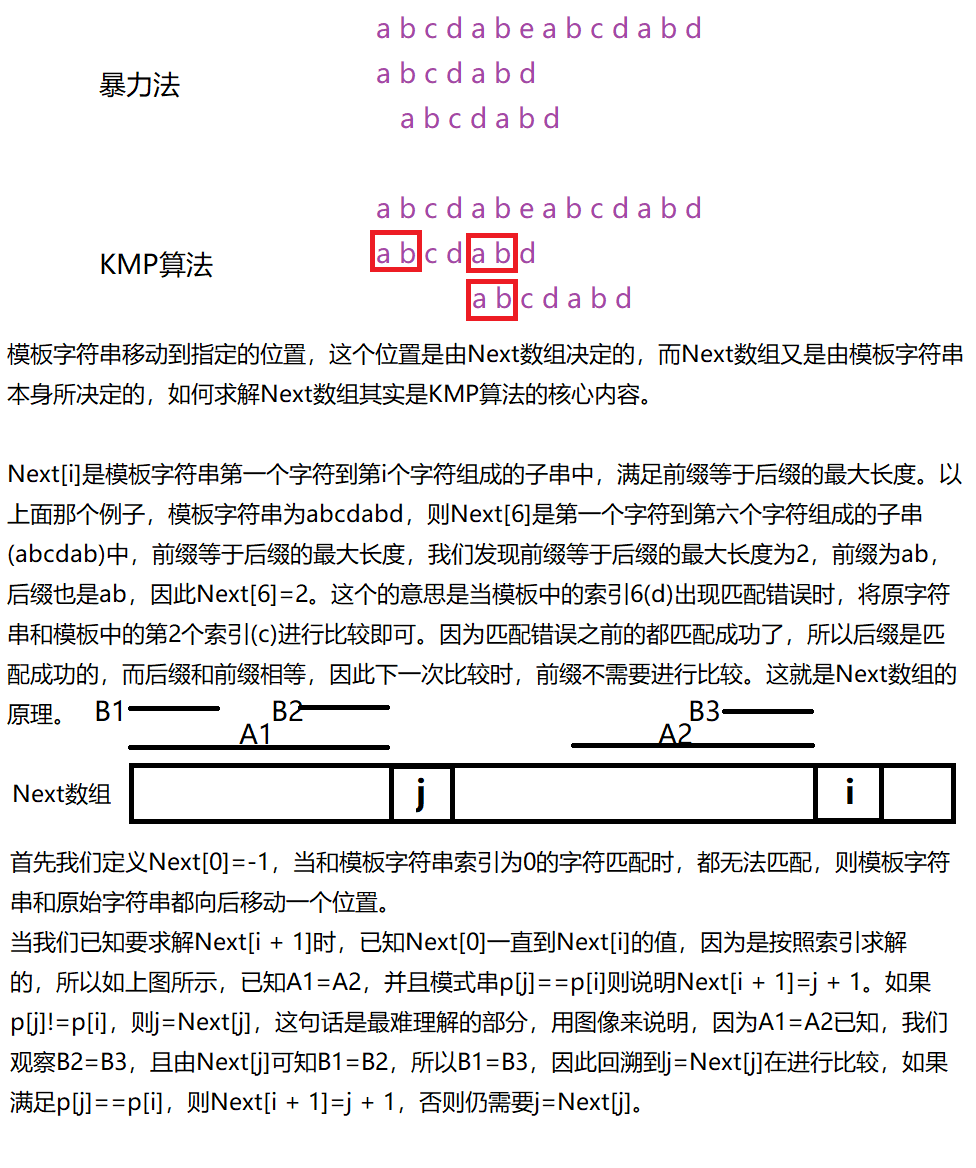
题目分析
这道题目简单来说就是一个字符串匹配问题,看起来很简单,但是想要降低时间复杂度较为困难。可以通过暴力法或者KMP方法求解。
暴力法
暴力法很好理解,长度已经给定,穷举所有可能的子串,并且与模板字符串比较,如果相等则输出出现的位置,否则输出-1即可,时间复杂度为O((N-L)L),空间复杂度为O(1),其中N为原始字符串长度,L为模板字符串长度。
1 | class Solution: |
KMP
KMP算法是一种专门解决字符串匹配的算法,因为暴力法浪费了太多的比较次数,尤其是前面的字符都匹配正确后,最后一个字符匹配失败,又要从头开始匹配,效率太低,而KMP算法可以完成O(N)的时间复杂度和O(L)的空间复杂度。
我们借用一下leetcode题解中宫水三叶(叶神)的图举例。

1 | class Solution: |
1 | class Solution { |
字符串哈希
这个题目事隔两年多,2022年11月又来打卡了,这次再提供一个新颖的解法——字符串哈希。
不妨设长度为k的字符串s = [c0, c1, c2, c3… ck-1],哈希值为
$$ hashcode(s_k) = c_0 \times b^{k - 1} + c_1 \times b^{k - 2} + c_2 \times b^{k - 3} + … + c_{k - 1} $$
记pattern的哈希是hashcode,长度为pl,而template的哈希需要动态去计算,因为pattern可能是template的一部分,即从m开始,则长度为pl的字符串的哈希值为
$$ hashcode(p_{m-(m + pl - 1)}) = c_m \times b^{pl - 1} + c_{m+1} \times b^{pl - 2} + c_{m + 2} \times b^{pl - 3} + c_{m + pl - 1} $$
两个字符串的哈希值如果相等,可以认为两个字符串相等(后面会进行解释)。如果对每一个位置都计算,则时间复杂度和暴力是一样的。
所以引入前缀和的思想,从索引0开始到m + pl的字符串哈希值为
$$ hashcode(p_{m + pl - 1}) = c_0 \times b^{m + pl - 1} + c_1 \times b^{m + pl - 2} + … + c_{m - 1} \times b^{pl} + c_m \times b^{pl - 1} + … + c_{m + pl - 1} $$
$$ hashcode(p_{m - 1}) = c_0 \times b^{m - 1} + c_1 \times b^{m - 2} + … + c_{m - 1} $$
根据上述两式可得
$$ hashcode(p_{m + pl - 1}) - hashcode(p_{m - 1}) \times b^{pl} = hashcode(p_{m-(m + pl - 1)}) $$
则从i开始长度为pl的hashcode可以表示为hashcode[i + pl] - hashcode[i] x b^pl,并比较这个值和pattern的哈希值是否相等即可。
这里有个问题,哈希值相等,结果就一定相等吗?
答案是不一定的,哈希会存在冲突,要计算b^pl次方,如果b是偶数,那么次方用int表示可能会导致结果为0。因为超过int表示,就会MOD 2^31。
因此b的选择一般为偶数,且为了防止哈希冲突,b会选择超过字符集的大小
超过字符集的目的是,尽量保证高位不相等时,结果不相等。
比如za和ab这两个字符串,如果选择b = 25,那么za = 25 + 0 x 25 = 25,ab = 0 + 1 x 25 = 25,那么就会冲突,导致错误结果。
本题是小写字母,字符集大小为26,因为26是偶数,那么选择27就是可以的。
这里还要注意一点:并不是选择27一定是可以的,因为curSum不是完全单调递增的,超过int32的最大值,就会变成负数,因此还是有极低的概率存在哈希冲突。此时如果没有通过,可以尝试更换b即可。
算法的时间复杂度为O(n),空间复杂度为O(n)。
1 | class Solution { |
刷题总结
字符串匹配问题是一个经典的问题,大多数学校或者数据结构算法课中都作为例子进行讲解,但是很难讲的非常透彻,因为这个问题太抽象,在这里我只能用文字进行描述,所以描述的可能更不清晰,小伙伴们以要理解我举得例子,尤其是j = Next[j]这一步,可以说是KMP问题的精髓,看懂了这一步基本上就可以明白算法具体在做什么了。这次又补充了字符串哈希的方法,后面也会讲解一些字符串哈希的题目,可以在本站点直接搜索字符串哈希,会检索到所有字符串哈希的题目。